China Railway History (1865-1949): First Stage
After the industrial revolution, the steam engine accelerated the development of transportation, and the railway was created. The United Kingdom constructed the first public railroad in the world, and then other western countries, such as United States, France, Canada, Germany, and Italy all followed the suit. About 150 years ago, the first train station was built in China.
Qing Government’s Rejection to Railway
First Wusong Railway
After the defeat of the Opium War (1839 - 1842), many countries attempted to build rail lines in China, but the proposals were still strongly rejected. Without the authorization of the rulers in the country, in 1876, United Kingdom and United States together built a railroad under the guise of a normal road construction project. The first rail line in China was Wusong Line, from Wusong to Shanghai with a length of 7.5 miles (12 kilometers). The Qing government did not wholly support the line and purchased it from the operating company. The Qing government subsequently willfully neglected the upkeep of the line and removed the rails. However, this line is still regarded as the first chapter of the Chinese rail history.
China's First Self-constructed Railway
During the Sino-Japanese War (1894-1895), Chinese people began to realize the great importance of the rail for military defense, so it was a chapter of awakening. In 1887, the rail construction work in Taiwan commenced, and the rail line from Taipei to Keelung and Hsinchu were completed respectively in 1891 and 1893.
Railway Construction by Western Companies
 |
However, western countries would not give up their attempts for rights and benefits in Chinese rail construction just because of the concession of the Wusong Line. Two rounds of commercial activities took place in this area, taking advantage of the Qing government’s weakness.
The first round took place from 1896 to 1903. France was granted the concession to build Dianyue Line, Germany for Jiaoji Line and United Kingdom for Huning and Guangjiu Line. Over 6,200 miles railroad’s construction right was conceded, but some projects were obstructed by Chinese people and only partially completed.
From 1903, some Chinese people advocated the reclamation of railroad construction rights granted to other countries. With the urgent demand, the Railway Rights Protection Movement was stirred up, and rights were returned in succession.
Among these, the first self designed and constructed rail Line by China, Jingzhang line (Beijing Fengtai to Zhangjiakou) was put into use in 1909, which was designed by the great rail engineer, Zhan Tianyou. He was appointed to be in charge of the rail construction, and the renowned Reversing Y-shape line was proposed by him, which was widely regarded as the most difficult project on account of the geography barrier, hence Zhan Tianyou enjoys the fame of “The Father and General Engineer of Chinese Railway”. By 1911, there had been 5,600 miles rail lines constructed, including Jingfeng, Binsui, Changbin, Changda, Anfeng, Jinghan, Jingzhang, Jinpu, Jiaoji, Zhengtai, Bianluo, Huning, Huhang, Zhuping, Chaoshan and Guangjiu rail lines.
The second round lasted from the collapse of Qing Dynasty to the end of the First World War (1912-1918).
In 1911, the Qing Dynasty collapsed thoroughly. Yuan Shikai, the leader of the northern warlords kept conceding the right of rail construction to western countries. Just within 5 years, the right for the 11 lines, about 6,200 miles (10,000 km), was sold out. However, influenced by the First World War, the right for most lines was not obtained by western countries.
Slow Development during Needy and War Time
During 1928-1948, the country's railway career did not develop smoothly and there were many problems. In the first place, before 1949, there were only about 14,602 miles (23,500 kilometers) constructed and only 6,835 miles (11,000 kilometers) were in service. Most rail lines gathered in northeast and coastal area of China, with only six percent extending to other areas. Secondly, the standards of the rail line were different from each other in specification, for the lines were constructed by different countries. Therefore, the rail network was in a great mess.
1949-2008: Massive Construction
2008-Present: High Speed Era
- Last updated on Aug. 06, 2025 by Grace Yang -